
Posts Tagged: Emily Bzdyk
Bugs at the Bohart
When the Bohart Museum Society throws a Halloween party, you can bet bugs will be there.In costume.Lynn Kimsey, director of the Bohart Museum of Entomology, located at 1124 Academic Surge on California Drive, UC Davis campus, knows that a Halloween party isn't a party without the appropriate...
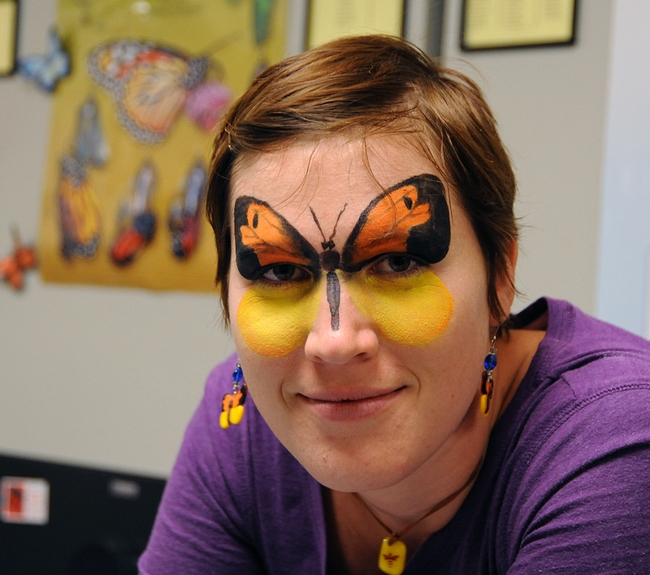
UC Davis graduate student Emily Bzdyk came dressed as a butterfly. She creates insect jewelry sold at the Bohart.(Photo by Kathy Keatley Garvey)
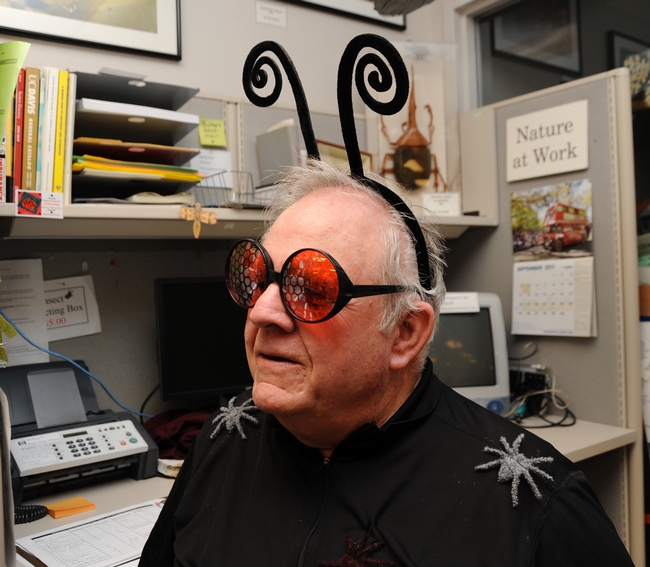
Insect photographer Tom Roach of Lincoln came dressed as a bug. (Photo by Kathy Keatley Garvey)
These bees 'cut it'
We're in the midst of a housing crisis, so why not build a 30-unit, high-rise condo in your yard?
No, not for people--for native bees.
We just installed a bee condo for leafcutting bees (Megachile spp.), on a five-foot high pole overlooking catmint, lavender and salvia. The "housing development" is actually a wooden board drilled with small holes to accommodate our tiny tenants. Comfy and convenient. Rooms with a view. No housing permits or EIR required. Rent-free, mortgage-free.
Leafcutting bees, aka leafcutter bees, are about the size of a honey bee but darker, with the characteristic light-banded abdomens. They are important pollinators.
Why are they called leafcutter bees? Because the females cut leaf fragments to construct their nests to raise their brood. In nature, they build their nests in soft, rotted wood or in the pithy stems of such plants as roses, raspberries, sumac and elderberry.
Unlike honey bees, which are social, the leafcutting bee is a solitary nesting bee. She provisions her leaf-lined nest with nectar and pollen, lays an egg, and seals the cell before leaving.
Commercially made bee condos are available at beekeeping supply stores or on the Internet. You can make or buy a board with different sized-holes so other native bees, such as blue orchard bees, aka mason bees, receive a "home, sweet home," too, and deliver pollinator services.
And enable you to tell your family and friends that you're a "bee landlord" or beekeeper.
The Xerces Society for Invertebrate Conservation offers tips on building bee condos on its website and in its publications, including Farming for Bees: Guidelines for Providing Native Bee Habitat on Farms.
If you don't want bee boards housing your tenants, you can provide straws or hollow bamboo stems.
At the UC Davis Department of Entomology, doctoral candidate Emily Bzdyk is doing research on leafcutter bees. "Basically I'm doing a revision of the subgenus Litomegachile, part of the large genus Megachile, which includes leafcutter and resin bees," she said. "They are native to North America. My goals are to find out how many and what the species are in Litomegachile, and find out as much as I can about their biology, or how they make a living."
"I also want to identify clearly what the boundaries between the species are, or how to tell them apart from one another," said Bzdyk, whose major professor is Lynn Kimsey, director of the Bohart Museum of Entomology. "Litomegachile are very common and hard-to-identify to species, and I feel they deserve attention."
Bzdyk noted that some Megachile are used in commercial alfalfa production. The alfalfa leafcutter bee, native to Europe, is used for commercial pollination of alfalfa, she said. "The Litomegachile is probably very closely related."
The alfalfa growers erect giant bee condos in their fields to draw bees to their plants.
With home gardeners, the effect is the same.
If you build them, they will come.
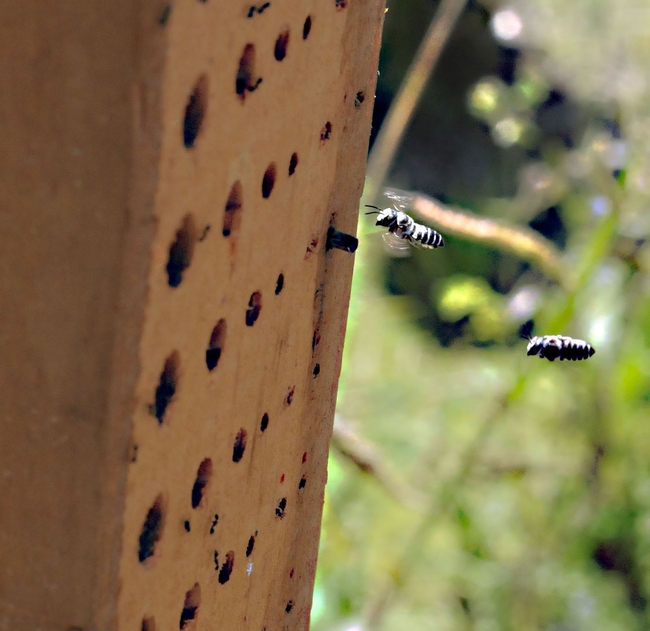
Leafcutting bees, aka leafcutter bees (genus Megachile) head toward a bee condo built for these and other pollinators. (Photo by Kathy Keatley Garvey)
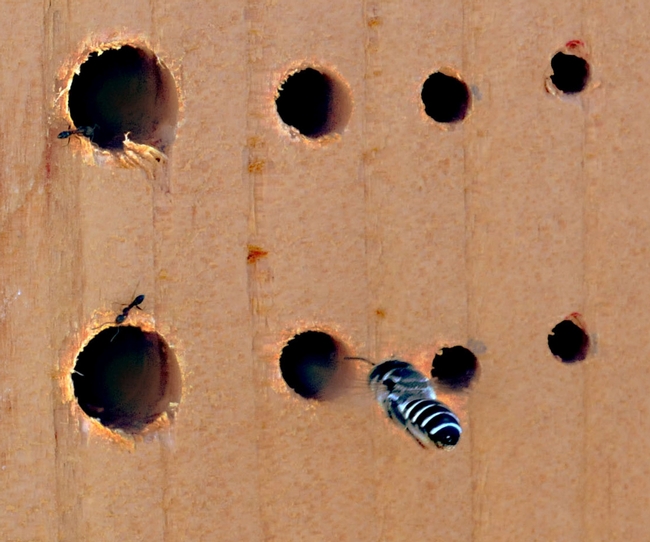
Home sweet home: Oblivious to ants, a leafcutter bee heads for home. (Photo by Kathy Keatley Garvey)
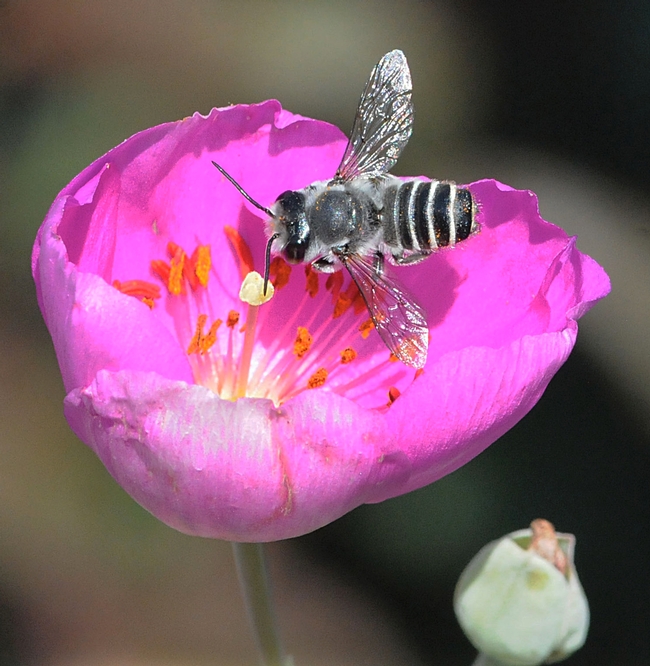
Male leafcutter bee (genus Megachile) sips nectar from a rock purslane. (Photo by Kathy Keatley Garvey)
An Entomologist and an Artist
If you’re a first-year graduate student in entomology, you spend much of your time buried in books or conferring with your major professor. Emily Bzdyk, who is pursuing her doctorate in entomology at UC Davis, does that, too--and more. She's heavily involved in art. Two of her art works will be...

Emily Bzdyk
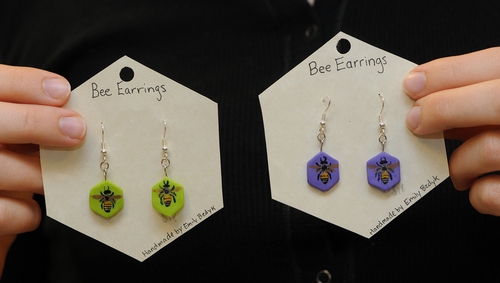
Bee Earrings
Going Buggy
Let's go buggy at the Bohart!The Bohart Museum of Entomology, which houses more than seven million insect specimens at its facility on the University of California, Davis campus, has extended its hours to include several weekends.The first will be Saturday, Feb. 13 from 1 to 5 p.m., and the theme ...

Praying Mantis

Emily and the Tiger
Hissers in the Bohart
It’s a comfortable life. Eat, sleep and mate. And then eat, sleep and mate again. Madagascar hissing cockroaches are a popular attraction at the Bohart Museum of Entomology at the University of California, Davis. The museum, directed by entomologist Lynn Kimsey, professor and vice chair of the UC...

Different Reactions

Bigger than Big
